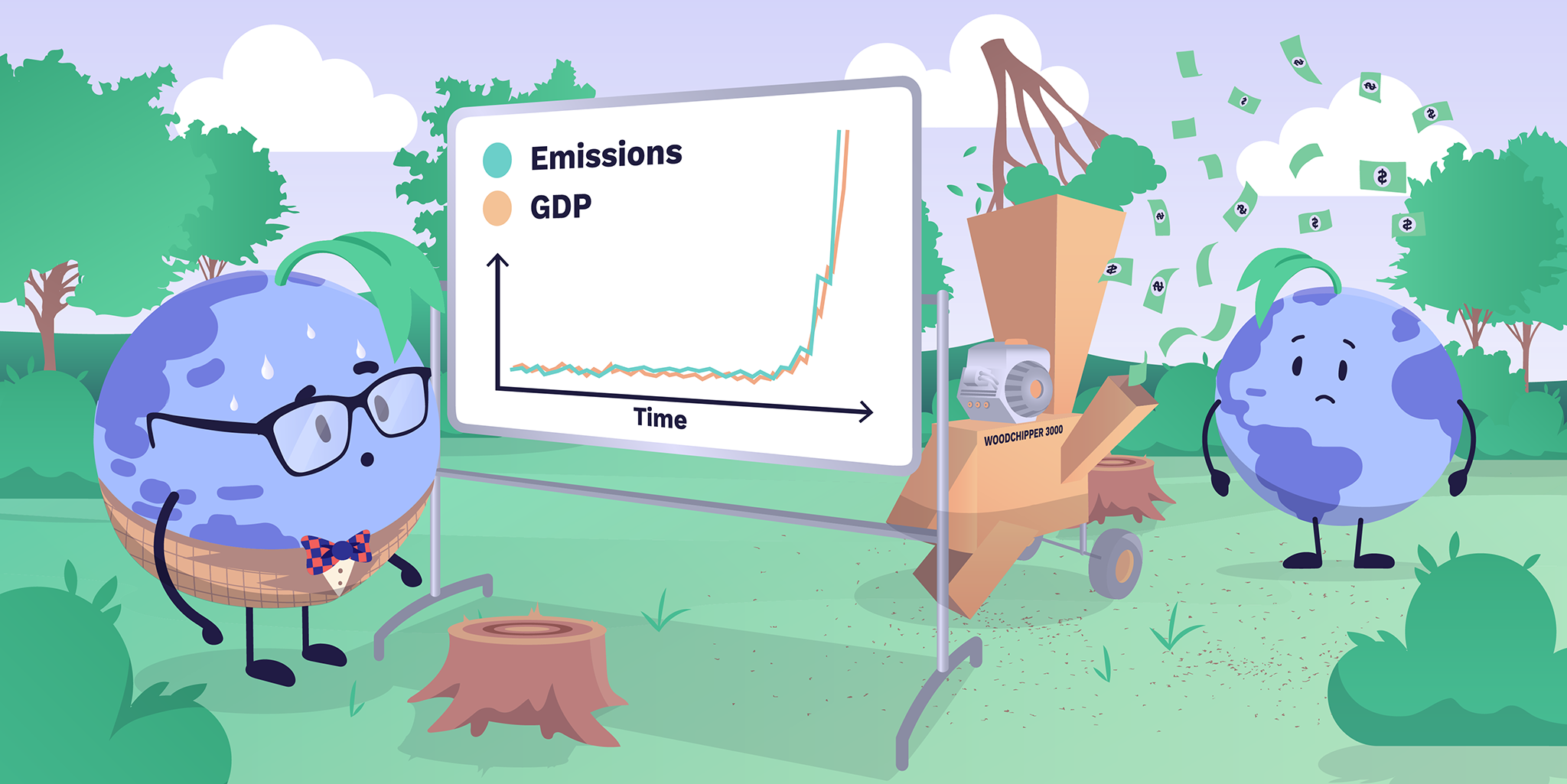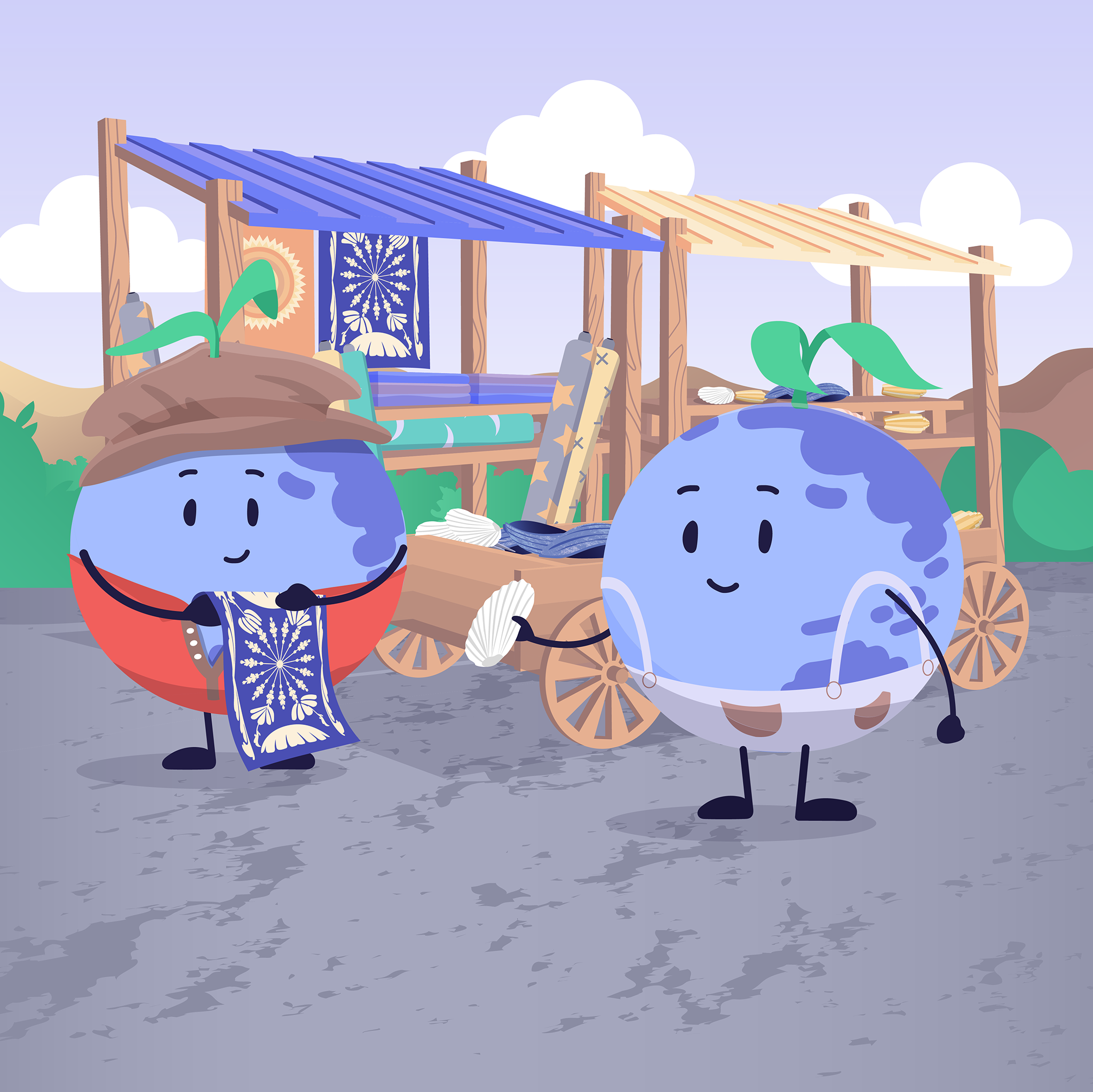Economy & Climate: The Greatest Market Failure
12 minute read
Updated on: 29 Aug 2021

Economics is about how products and services (like apples or life insurance) are made, and who uses them . In this course, we’ll delve into the nitty-gritty details of the economic world, because it has a huge effect on climate change!
Our current economic system is all about getting us to buy more things - whether we need them or not. We can see this in advertising all over the place: consuming products and services is shown as something that will make us happier. But all this consumption comes at a cost to the environment and society.
So how did we end up here? To find out, we’ll need to start at the beginning: let’s talk about markets.
The role of markets in society
Markets have existed for a long time . They have taken many forms and covered many different trades such as trading food for a place to live in medieval Europe or buying products with seashells in ancient China
.

Earthlies trading products
Markets can sometimes be used to help us work out the value of something. Value can be thought of as how much something is worth; for example, how many things you can buy with a gold coin determines the coin’s value.
As societies grew and became more and more complex, so did our markets. Trade became more global and with that came the ideas, science and materials to invent new things
. Before this point, our economies were mostly based on agriculture and hand-made goods, but that all changed as our economy shifted to one based on machine manufacturing and industry
.
The industrial revolution: A pivotal moment in economic history
The industrial revolution was a period of time during the 18th and 19th centuries where humanity saw an explosive increase in productivity . Increasing productivity means that you’re able to produce more things with fewer resources (energy, materials, labour) or in a shorter amount of time
.

Agriculture-based economy vs an industry-based economy
All these innovations meant that we could make a lot more stuff much faster and cheaper than ever before; in other words, we increased our productivity. This was aided by more global trade: for example, a factory owner in Liverpool, UK, could now sell their products to millions of people around the world rather than to a few thousand people in Liverpool. This increased the demand for faster and more efficient production
.
In addition, further improvements to agriculture meant that fewer people were needed to work in farming and could instead work in other sectors, such as manufacturing .
All of these ‘increases’ led to what we call economic growth. While this growth has come with many benefits to human society, it has also been a major contributor to our current global predicament: climate change .
Measuring Growth
Economic growth means that more products and services will be produced in a given period of time .
The most common way to measure the economic growth of a country is the gross domestic product (GDP). This is defined as the total value of all final products and services produced within a country during a given period
. But isn’t calculating this number impossible? Well, a simplified approach uses the following formula:

A simple way to explain how GDP is calculated
By adding all of those variables together you can get an estimate of a nation’s GDP. However, you might have noticed that GDP doesn’t differentiate between good expenditure and bad expenditure.
This means that GDP increases even if the expenditure is harmful to humans or the environment. For example, an oil spill actually causes GDP to increase! This is because workers would be needed to assess the damage; cleaners would work for months to soak up all the oil; scientists would need to help repair the ecosystem, and engineers would have to repair the source of the spill. All of these people would need to get paid and they would eventually use that money to buy other things. Resources and materials would also be bought to help with the clean-up. This all increases GDP.
So, a country having a high GDP isn’t necessarily a good thing because it may be taking into account a lot of “bad” expenditure, such as oil spills.

Oil spills actually increase GDP
Oil spills are unfortunately just one example. GDP is used to measure a nation’s “progress” but it doesn’t take into account how happy or healthy people are, whether the natural environment is being damaged, or whether income inequality is growing . It also doesn’t include non-paid work that people do, such as cooking, cleaning, and care work at home
.
As Robert F. Kennedy once said in 1968, “The gross domestic product does not allow for the health of our children, the quality of their education, or the joy of their play. It measures everything, in short, except that which makes life worthwhile”.
While many argue that a higher GDP leads to a better quality of life, beyond a certain limit, increasing income and wealth does not necessarily lead to higher levels of happiness
. Happiness is actually more closely related to the quality of social relationships and a sense of purpose in life rather than to additional income or wealth
.
Bhutan (coincidentally one of the only carbon negative countries in the world) uses a different metric to measure its “growth”. It uses a gross national happiness index (GNH) that is composed of 124 variables to determine the prosperity and progress of its nation
.

Bhutan’s GNH takes into account many different variables
So, now that we know a way to measure growth, let’s look at its role in causing climate change.
Economic Growth: Is more always better?
Economic growth is actually fairly new, only really taking place over the last couple of centuries.
In fact, our economic history can be split into two acts. The first act lasted thousands of years: most people were poor and societies achieved little (if any) growth
. Human life didn’t change much: the things people used for shelter, food, light and energy remained pretty similar for a very long time
.

Economic history remained mostly unchanged until very recently
The second part (as you can see) is much shorter and much more dramatic. As we discussed before, this change mostly came from the industrial revolution.
On average, a person in the UK now makes more money in 2 weeks than the average person in 1650 would make in an entire year !
This huge amount of growth has led many to question whether it can be sustained in the long run. The rise in using resources (and their effect on the environment) has followed a population growth and rising incomes: can this continue forever
?


A huge rise in societal transformations and impacts
By definition, infinite growth within a closed system (the Earth) is quite literally impossible. We are already starting to see the effects of what increasing growth means for our planet. In fact, there is a day called Earth overshoot day, at which we use more resources than the planet produces in one year
.
In 2019, Earth overshoot day was on the 29th of July. This means that we used up one year’s-worth of planetary resources in under seven months
! This is the earliest it’s ever been; in 2020 it was on the 22nd of August because resource use was slower due to the COVID-19 pandemic
.

Overshoot Day 1970-2020
Although globally on average we would need 1.6 Earths to sustainably meet the amount of resources we use, very different amounts are used country to country. For example, if everyone lived the lifestyles of the people of Canada we would need just over five Earth’s worth of resources
. But if everyone lived the lifestyle of the people of Burundi, we would only need 0.39 Earths to satisfy our resource needs
.
So, our current way of thinking prioritises some individuals’ satisfaction over everyone else’s well being. This problem is driven by both sides of the transaction: consumers and the companies which prioritize profits over environmentally-friendly practices.
Climate change: The greatest market failure
When you buy a car, the costs that you think about are the price of the car, insurance, maintenance, and the fuel you need to drive it. The costs that you don’t think about are any secondary effects. For example, your car’s exhaust fumes may cause your neighbor to develop asthma - yet their medical bills are not related to the cost of your car.
This is referred to as a negative externality: when society pays some of the cost of an individual purchase
. This can also be referred to as a market failure. Climate change is said to be the greatest market failure of them all
. Individual purchases don’t include the cost to the world of climate change: lost biodiversity, ocean acidification and extreme weather events
.
Despite how damaging our economic system has become, we can’t just stop the economy in its tracks. The COVID-19 pandemic has shown us what an immediate slow-down of our economy looks like, and so far it has been devastating across the planet as millions have lost their jobs and businesses have failed.
Our way of thinking about the economy requires some fixing. We need things to reflect their true cost to society and the environment. This should help ensure our planet’s limited resources are taken care of in a fair and sustainable way.
Now that we understand how we got to where we are, and have a basic understanding of how our economy works, we’ll delve into understanding the main current economic system: capitalism.
Next Chapter